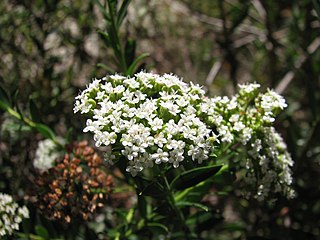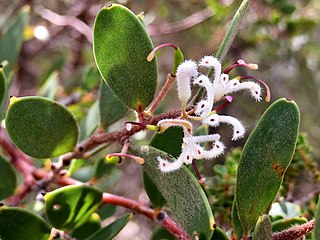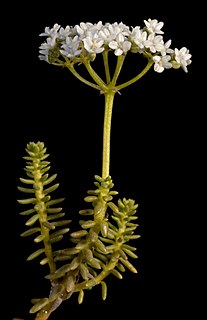
Elaeagnus, silverberry or oleaster, is a genus of about 50–70 species of flowering plants in the family Elaeagnaceae.

Elaeagnus commutata, the silverberry or wolf-willow, is a species of Elaeagnus native to western and boreal North America, from southern Alaska through British Columbia east to Quebec, south to Utah, and across the upper Midwestern United States to South Dakota and western Minnesota. It typically grows on dry to moist sandy and gravel soils in steppes, meadows or woodland edges.

Platysace is a genus of woody perennial herbs and subshrubs in the family Apiaceae. The genus is endemic to Australia.

Platysace linearifolia, known as carrot tops, is a slender shrub, found growing on poor sandy soils in eastern Australia, north of Jervis Bay. It may form large colonies and is easily noticed in the late summer and autumn when covered in small white flowers. It grows from 40 cm to 1.5 metres tall. A feature of this plant is the linear leaves, 10 to 25 mm long, and 0.5 to 1 mm wide. The fruit is 2 mm long and wide, with tubercles.

Platysace lanceolata, commonly known as shrubby platysace, is a shrub species that is native to south-eastern Australia. It grows to 1.5 metres high and has leaves that are 10 to 50 mm long and 4 to 5 mm wide. Plants produce umbels of small white 5-petalled flowers between December and February in the species native range.

Grevillea leucoclada is a shrub of the genus Grevillea native to a small area on the west coast in the Mid West region of Western Australia.

Hakea commutata is a shrub in the family Proteaceae native to Western Australia. A variable species in shape and growing requirements, including mallee heath, sand and along creek lines.
P. commutata may refer to:
Salix commutata, the undergreen willow, is a plant species native to western Canada and the northwestern United States. It has been reported from Alaska, Yukon, the Northwest Territories, British Columbia, Alberta, Saskatchewan, Montana, Idaho. Washington and Oregon. It grows on rocky alpine and subalpine slopes, conifer forests, stream banks, bogs, etc.

Persoonia sulcata is a plant in the family Proteaceae and is endemic to the south-west of Western Australia. It is a small, erect or low spreading shrub with narrow, linear leaves and cylindrical yellow flowers arranged singly or in groups of up to three in leaf axils. It grows in woodland or on rocky slopes and is found in several disjunct populations.

Hakea lasiantha, commonly known as the woolly-flowered hakea, is a shrub in the family Proteacea endemic to an area along the south coast in the South West and Great Southern regions of Western Australia.

Hakea stenocarpa is a shrub in the family Proteacea, commonly known as narrow-fruited hakea. It has scented creamy-white flowers in clusters, often with curling leaves and is endemic to an area in the Mid West, western Wheatbelt, Peel and the South West regions of Western Australia.
Grevillea commutata is a shrub of the genus Grevillea native to an area along the west coast of the Mid West region of Western Australia.
Grevillea pinifolia, commonly known as the pine-leaved grevillea, is a shrub of the genus Grevillea native to a few small areas in the central Wheatbelt region of Western Australia.
Grevillea yorkrakinensis is a shrub of the genus Grevillea native to Western Australia.
Platysace maxwellii, commonly known as native potato or karno, is a shrub that is endemic to Western Australia. The Noongar names for the plant are karno and yook, with the latter name also referring to the closely related species Platysace deflexa which grows further south.
Platysace compressa, commonly known as the tapeworm plant, is a perennial herb that is endemic to Western Australia.

Conospermum crassinervium, commonly known as the summer smokebush or tassel smokebush, is a shrub endemic to Western Australia.

Hibbertia commutata is a shrub in the Dilleniaceae family that is native to Western Australia.

Platysace deflexa, known by its Noongar name Youlk or as Ravensthorphe radish, is a small shrub endemic to the south west of Western Australia.










